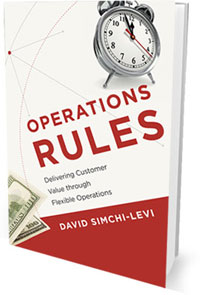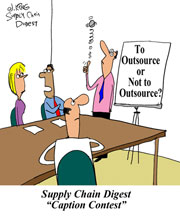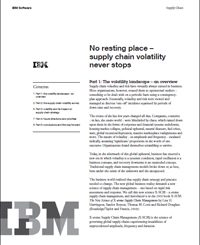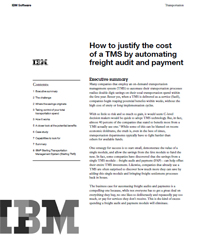 |
March 29, 2012 - Supply Chain Newsletter |
 |
This Week In SCDigest
FEATURED SPONSOR: AspenTech |
||
View the Short Video on |
||

Readers Respond: Metrics and Supply Chain Performance Several times a year, I get the luxury of having enough quality reader feedback from one of these columns to make a column on its own - and easy week for me. Such was the case after a couple of columns I wrote in the recent past on metrics and supply chain performance. (See part 1 and part 2.) We certainly have had more feedback from a total number of emails before, but this was among the best ever in terms of depth of response.
To greatly summarize, I argued that metrics systems today in many companies are so strong that it would seem hard for them to get too far off the rails in terms of supply chain performance. Miss your numbers for very long, and you are soon "looking for new opportunities." Yet, there are major differences in supply chain performance across companies. Ergo, this must frequently be the result of setting metrics targets too low, out of gamesmanship or lack of awareness of what can really be achieved. It is also very consistent with a phenomenon I have been writing about for many years that I call the 50% problem. That is that most companies tend to rate their supply chain performance as high, even though by definition 50% are in the bottom half of performance. The always thoughtful Trevor Miles of software provider Kinaxis largely agreed with me, and offered some related interesting ideas on the topic. The first was that "the craziest" supply chain metric is conformance to plan. "Measuring plan conformance shouldn't occur at more than a daily level, perhaps allowing that in fairly stable industries this could go out as far as a week," Miles wrote. Anything more than that "is crazy because of the assumption that he plan was correct in the first place."
Jane Barrett, a very smart analyst who is driving Gartner research agenda these days, wrote that "I loved your piece on metrics - so true." From her perspective, the issue is that "basically companies don’t know how to use the metrics. It’s not that they don’t measure enough!" Is that right? Seems like at one level metrics should be commonsense enough, but Barrett restated Gartner's long term position that companies need a "hierarchy of metrics" to help them really focus on what is important in a structured way. My friend Steve Murray of consulting and training firm Supply Chain Visions, which focuses on supply chain metrics as a core component of what the company does, agreed with me in part, but had a somewhat different perspective, in part along the same lines as Barrett's thinking. He wrote that its "not just metrics, but the right metrics and the right target levels for the situation. This can change a bit from facility or product/customer type even in the same company." He said he actively promotes programs along the lines of the example I gave of Sara Lee, which had a cascading series of "line of sight" metrics flowing from it S&OP process, or what Murray said are "metrics driven by corporate strategy at the top and linked down throughout the business to each functional area and work center. This may end up with a large number/variety of measures total for the business, but we like to see something in the range of 3-5 at each level."
I agree in part, but my point remains that if the targets are not set correctly, it results in what appears to be "desirable" performance when it is really "undesirable." That good/bad dichotomy is based on internal targets, which may not be what should really be achievable. Consultant and former supply chain executive David Schneider took a little bit of a humorous approach to his response, starting by asking what in fact a KPI really means. "I saw a definition on the white board in a DC manager’s office years ago that said 'KPI = Keep Pushing Idiot!' Surrounding that were about 10 different measures that the DC manager said were irrelevant to his operation, but he had to calculate and send to corporate," Schneider wrote. "A manager needs to know more than what his goals are. He must be able to measure his performance and results against the goal," Schneider added. "Many think that is where KPIs come into place. For this practice to work well, you have to set hard, achievable and time-bound goals that challenge the manager." Schneider also argued that a specific increase in Operating Cash Flow (OCF) is the perfect measurable goal. "Frankly, I don't care what the manager does in detail to measure himself as long as he understands that the only measure I am going to use for him is how he contributed to company OCF," he says. "Go ahead and argue that operating cash flow is too broad of a goal, or too hard for a manager to understand. I will just give you a blank stare of contempt," Schneider added. " Operating Cash Flow is not hard to understand, and a good leader will help a manager understand what activities a manager does that delivers positive OCF." Consultant Nick Seiersen says that "I have seen many organizations track performance to a set of metrics, doing things they knew were not optimal for the business, but that drove a payoff, such as a bonus entitlement. There are other companies that have not worked through what really counts, or how to measure it." Padmini Ranganathan of SAP agrees that developing a process in which companies really evaluate what performance targets really should be set will "require an organization change in mindset." He notes a solution SAP has developed (I am allowing free plug here based on the good feedback) that helps companies identify the right metrics and targets and then cascade those goals down through the rest of the organization for say something like cash-to-cash cycle goals. Sherry Gordon of Value Chain Group says she thinks that differences in supply chain performance are due primarily to two factors.
Second, "companies measure those things that can be easily measured rather than what is important to the business. This can be due to not having readily available sources of data to create the desired KPIs. Or, a firm has not aligned its scorecards with company strategies and goals, by following the approach that you describe at Sara Lee, resulting in metrics that are a hodgepodge of what’s available in their system and what they think they should measure, but not based upon a robust metrics development process." I think both points are worth self-examination, though with regard to point 1 I believe managers get fired today for not meeting objectives more rapidly than they ever have. There was more feedback, but I am out of space. Thanks for the submissions, and I hope you enjoyed them as much as I did. Some of the full responses are published below. More next week.
|
|
||||||||||||||||||||||||||||||||||||||||||||||
Upcoming Videocast:
The End of Cheap Oil

Is Your Supply Chain Obsolete?
Conserve, Cooperate, Get Lean.
Featuring Chuck Taylor, Former Transportation Executive, Founder of Awake!, and Peak Oil Prophet; Greg Holder, CEO and Founder, Compliance Networks; and Kevin Harris, Director, Compliance Networks
Upcoming Videocast:
Operations Rules for Driving
Business Value & Growth

Part 2: Supply Chain Segmentation for Improved Profitability -
Strategies to Trim the Long Tail
Featuring Dr. David Simchi-Levi,
Professor of Engineering Systems, MIT
Important Research Project:
Building the Supply Chain from the Shelf Back

These responses will be aggregated and become part of a new report on Building the Supply Chain from the Shelf Back to be released later this Spring.
Can you please help by taking this quick 10 minute survey? All respondents will receive a summary of the data in just a few weeks.
As promised above, below are a handful of the Feedbacks we received on our First Thoughts columns on metrics and supply chain performance. That includes our Feedback of the Week from David Schneider of David K. SchneIder & Company, who as usual responds with some flare. You will find others as well, and more next week.
Feedback of the Week: On Metrics and Supply Chain Performance: |
||
I suggested that he change the "Idiot" to "Information" - as in "Keep Pushing Information", just so his opinion did not reach the pointed hair boss. Could it mean Knowledge Power and Image? Being a student of that old man Peter Drucker, I look at measurements as a form of manager self-control. Drucker teaches us that the greatest advantage of management by objectives is that the manager controls his own performance. Now Drucker always considered the word control to be in ambiguous word. In his mind it meant that the manager had the ability to direct one's self and one's work. Drucker stressed that the major contributions of management by objectives is that it allows management by self-control to replace the practice of management by domination. A manager needs to know more than what his goals are. He must be able to measure his performance and results against the goal. Many think that is where KPI's come into place. For this practice to work well, you have to set hard, achievable and time bound goals that challenge the manager. Drucker argues that you set a managers goal in a broad sense - something that means something real to the company, and something that the manager understands contributes to the success of the company. I argue that a specific increase in Operating Cash Flow (OCF) is the perfect measurable goal. Frankly, I don't care what the manager does in detail to measure his himself as long as he understands that the only measure I am going to use for him is how he contributed to company OCF. Go ahead and argue that operating cash flow is too broad of a goal, or too hard for a manager to understand. I will just give you a blank stare of contempt. Operating Cash Flow is not hard to understand, and a good leader will help a manager understand what activities a manager does that delivers positive OCF. Yes, there's a whole variety of detailed measures that have an effect on operating cash flow. It is the duty of the managers to figure out how to measure the details of their operation that helps them manage and control the functional area to create more OCF! Too often KPI's are created by the bosses, or by the engineers, delivering a greater world of dueling goals - goals that are in apparent conflict. An example is the need to increase productivity and reduce error rate. Both can contribute to OCF, but there is no guarantee if managers don't make the effort to leverage the gains. I have witnessed countless productivity improvement projects that just created more free time for ways to waste, not adding any profitability because managers chose not to pay attention to the monetization of the KPI improvement. Perhaps KPI means Key Panacea Image? Companies that engage in benchmark measurement and metrics not to improve but for their ego's, to show how well they are doing against other companies. The annual WERC DC Measures could be considered an example of the "my numbers are better than your numbers" process. Before anybody gets up in arms, I believe that the WERC metrics and benchmarking process is a worthwhile effort, as long as you keep a very large grain of salt handy. Other benchmarking efforts, including Mr. Tompkins Supply-Chain Consortium, the transportation cost benchmarking Chainalytics provides, and a whole host of other industry segment benchmarks have their place. These are positive activities for supply chain managers to engage in as long as the managers make a commitment to use the data with a worriers commitment to victory! A well done benchmark effort will deliver imagery of the company's imperfection and operational impotence, highlighting the possibility of improvement as long as management doesn't engage in the insanity of inaction. Maybe we could use the term Kindred Perfection Influence for benchmarking exercises. As in you must make sure that you measure yourself against the kindred company, that you measure perfection the same way, and that you make the commitment to be influenced by the results to take action. Returning to the teachings of Mr. Drucker, I think it is very hard to argue against Operating Cash Flow as a measurable goal. OCF is a clear measure of success or failure of the business enterprise. OCF doesn't work very well when comparing one business to the next, but definitely is a great measurement for an individual enterprises performance. Following Drucker's mandate of self-control of the manager, it is incumbent upon the functional manager to determine not only the performance of his realm, but how his performance contributes to the collection of the gold. David K. Schneider |
||
More on Metrics and Performance:
|
||
As you know, we folks at Supply Chain Visions are pretty serious about the value of Metrics and Performance Measurement / Management / Improvement. Not just "metrics", but the right metrics and the right target levels for the situation. This can change a bit from facility or product / customer type even in the same company. We promote and firmly believe in what you saw with Sara Lee - metrics driven by corporate strategy at the top and linked down throughout the business to each functional area and work center. This may end up with a large number / variety of measures total for the business, but we like to see something in the range of 3-5 at each level. If this structure can be built, and the individual measures captured easily and economically then rolled up through the levels of the business it is like Heaven on earth. BUT, this will not ensure success. Having the right metrics can tell you if you hit your target, but it won't do much more. A good performance management and process improvement program, linked to the metrics will help. Training of employees on the value of their work and how it affects customer satisfaction and profitability - future viability of the business also helps. Finding the root cause for lower that desirable performance and letting the employees who do the work understand the business strategy and develop solutions to the problems builds a foundation that will reap dividends ongoing as problems are resolved in a timely manner at the lowest level possible. This is part of something we call Validating the Value Add. A companywide performance management strategy which functions at the grass roots. I don't think the targets are the problem as much as what is done with the results. Steve Murray Supply Chain Visions |
||
0n Metrics Strategies - I think you are spot on - what is being measured is likely the wrong thing or is measured at a superficial level that doesn't tie to actual business operations. We can also be hurting ourselves with averaging and aggregating - we need to look at the high level, but we must be aware of the exceptions and their root causes, then we know we are looking at the right measures. I think corporations can get stuck on metrics and use the same ones forever vs. adapting them as the business needs change for various reasons. Emily Rodriguez Intel |
||
SUPPLY CHAIN TRIVIA ANSWER
Q: The Panama Canal expansion set to be complete in 2014 will increase the ship capacity from what level currently to what level when the project is done?
A: From 5000 or so currently to as much as 14,000 after completion, in what could be an ocean freight game changer.
| © SupplyChainDigest™ 2003-2012. All Rights Reserved. SupplyChainDigest PO Box 714 Springboro, Ohio 45066 |
POWERED BY: XDIMENSION |








